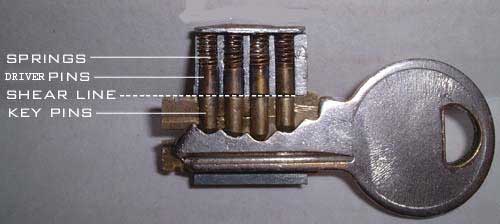paulchin20 LOCKPICKING TUTORIAL
Last Updated: December 6, 2004 at 10.57 am (Peninsular Malaysia time)
Lockpicking is defined as manipulating a lock to open it without the use of, or,
access to the correct key.
The instructions here apply to pin-tumbler and wafer locks - which comprise about
90% of all locks. If you are not sure what a pin-tumbler or wafer lock is, look at
the key. See pictures below.

 If any lock has keys which look like the pictures above, then that is a pin-tumbler
or wafer lock.
If any lock has keys which look like the pictures above, then that is a pin-tumbler
or wafer lock.
ONLY 3 TOOLS
Most of the time, I use only 3 lock picks: 1. HOOK pick 2. DIAMOND pick (also called half-diamond pick) 3. TENSION WRENCH Here are some pics: The top instrument is a multipick, it has 2 heads. On one end is the hook pick, and on
the other end is the diamond pick. The pick is meant to be inserted into the keyhole (keyway)
of a lock in order to manipulate the pins or wafers.
The bottom instrument is a tension wrench. A tension wrench is also inserted into a keyhole,
but not entirely, just partially. I usually insert it at the bottom of the keyhole (keyway).
The tension wrench is also called torsion wrench. Its purpose is to turn the keyhole (actually
the correct term is the plug, the keyhole is in the plug) in order to provide a constant
torque (rotational pressure) while picking. Once a lock is successully picked (using the
hook or diamond pick), the tension wrench will rotate freely and the lock
opens. In such a case, we say that the tension wrench acts as a key.
The next picture below is another lock pick set. The hook pick and the diamond pick
tools are separate. Whether you prefer the multipick or the separate pick is just
a matter of personal preference. In terms of functionality both sets can open locks.
The top instrument is a multipick, it has 2 heads. On one end is the hook pick, and on
the other end is the diamond pick. The pick is meant to be inserted into the keyhole (keyway)
of a lock in order to manipulate the pins or wafers.
The bottom instrument is a tension wrench. A tension wrench is also inserted into a keyhole,
but not entirely, just partially. I usually insert it at the bottom of the keyhole (keyway).
The tension wrench is also called torsion wrench. Its purpose is to turn the keyhole (actually
the correct term is the plug, the keyhole is in the plug) in order to provide a constant
torque (rotational pressure) while picking. Once a lock is successully picked (using the
hook or diamond pick), the tension wrench will rotate freely and the lock
opens. In such a case, we say that the tension wrench acts as a key.
The next picture below is another lock pick set. The hook pick and the diamond pick
tools are separate. Whether you prefer the multipick or the separate pick is just
a matter of personal preference. In terms of functionality both sets can open locks.

Yet another picture is shown below. This set is a barebones set consisting of only
a tension wrench and a hook pick. The hook pick is used not only for pin pressing
technique but also used for the raking technique.

ONLY TWO TECHNIQUES
I use only 2 techniques in lockpicking: 1. RAKING Technique 2. PIN PRESSING Technique I use raking on all locks. I use Pin Pressing only on Padlocks. Sometimes I combine both techniques when picking a lock. Rake first, only if it cannot open, use pin-pressing. To give you a quick general idea of what raking & pin-pressing is all about, you can watch the 2 video clips below. Watch a video clip of a guy doing the raking technique:
rakingdeadbolt.wmv (File size: 484 kB) Watch a video clip of me demonstrating the pin pressing technique:

pinpressing.wmv (File size: 520 kB)